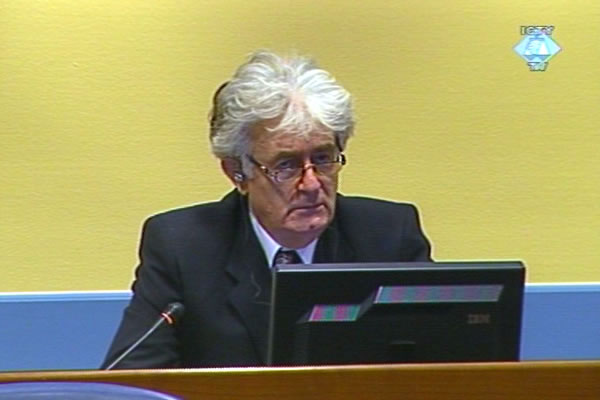Home
KARADZIC REJECTS SARAJEVO INVESTIGATIONS
The judges asked ballistic expert from the Sarajevo Security Services Center Mirza Sabljica to explain the methodology he and other members of the investigation teams used to determine the direction from which artillery and sniper rounds were fired, killing and injuring civilians in Sarajevo. The accused claims that the investigations were ‘sloppy’
 Radovan Karadzic in the courtroom
Radovan Karadzic in the courtroom Ballistic expert from the Security Services Center from Sarajevo Mirza Sabljica continued his evidence at the trial of Radovan Karadzic. The judges asked Sabljica to explain the methodology used by his investigation team at the scenes of artillery and sniper incidents to determine the direction from which the rounds that killed Sarajevo civilians had been fired.
On impact, the shells leave a print in an oval shape, fanning out from the centre; on the basis of those prints, it is possible to determine the direction from which the projectile was fired, the witness explained. The personnel of the Security Services Center used a method called the ‘central axis method’ and other techniques to calculate ‘the sines and cosines’ of the directions from which the shells were fired. The witness explained the methods using the incident in Dobrinja as an example. More than ten persons were killed and over a hundred were injured there on 1 June 1993.
Karadzic had asked for 30 hours for the cross-examination of the ballistics expert from Sarajevo, but was granted only seven hours. The judges decided it was ‘more than enough’ time to cover all the relevant topics.
In his effort to corroborate his argument that the investigations in Sarajevo were ‘sloppy’, Karadzic noted that the investigative judge never visited the scene in the Livanjska Street where a five-year-old girl was killed on 8 November 1994. The witness agreed that an investigative judge should have been present but couldn’t remember why he was not able to come to the crime scene.
Karadzic also questioned the witness about the shelling of civilians who were queuing for humanitarian aid in Dobrinja on 4 February 1994. Eight persons were killed and at least 18 were injured. Karadzic also asked the witness about an earlier incident, on 22 January 1994 at Alipasino Polje, when six children were killed and five persons were injured.
Karadzic asked the witness to draw lines on a map from the site of the explosion at Alipasino Polje to the Institute for the Blind in Nedzarici – where the Serb forces were located – and to the students’ halls of residence and the Oslobodjenje building in the BH Army-controlled territory. Karadzic put it to the witness that in this and in all other incidents listed in the indictment, the rounds could have been fired from the territory under the ‘Muslim control’.
In his cross-examination, the witness said he was offended by Karadzic’s use of the term ‘Muslim forces’ for the BH Army, asking the accused to use the correct names for the warring sides.
Karadzic will complete his cross-examination tomorrow. The prosecution will then call its next witness.
Linked Reports
- Case : Karadzic
- 2010-10-11 THOUSAND DAYS OF UNCERTAINTY
- 2010-10-08 KARADZIC HAD ABSOLUTE CONTROL
- 2010-10-07 KARADZIC – NATO WAS “TRIGGER HAPPY”
- 2010-10-13 ‘RAISING DOUBTS’ ABOUT SARAJEVO INVESTIGATIONS FINDINGS
- 2010-10-14 KARADZIC: WE NEED RECONCILIATION THIS YEAR, NOT NEXT
- 2010-10-15 TRIBUNAL EXPECTS BH TO COOPERATE VOLUNTARILY
